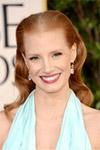Jessica Chastain The Zookeeper's Wife
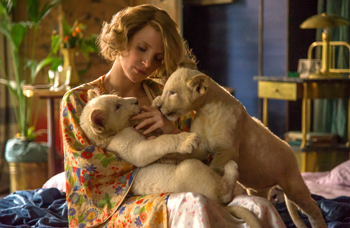
Jessica Chastain The Zookeeper's Wife
Cast: Jessica Chastain, Daniel Bruhl, Johan Heldenbergh
Director: Niki Caro
Genre: Biography, Drama
Rated: M
Running Time: 126 minutes
Synopsis: Two-time Academy Award nominee Jessica Chastain stars in The Zookeeper's Wife in the title role of Antonina Żabińska, a real-life working wife and mother who became a hero to hundreds during WWII. Niki Caro (Whale Rider, North Country) directs the movie from a screenplay by Angela Workman, adapted from Diane Ackerman's nonfiction book of the same name which was based on Antonina's diaries.
The time is 1939. The place is Poland, homeland of Antonina (portrayed by Ms. Chastain) and her husband, Dr. Jan Żabiński (Johan Heldenbergh, of The Broken Circle Breakdown). Devoted to each other, the couple thrive as personal and professional partners; the Warsaw Zoo flourishes under Jan's stewardship and Antonina's care. With reserves of energy, Antonina rises every day to tend to both her family and their menagerie, as the gates to the majestic zoo open in welcome…
…until the entrance is slammed shut and the zoo is crippled in an attack as the entire country is invaded by the Germans. Stunned, the couple is forced to report to the Reich's newly appointed chief zoologist, Lutz Heck (Golden Globe Award nominee Daniel Brühl of Captain America: Civil War). Heck envisions a new, selective breeding program for the zoo.
Antonina and Jan fight back on their own terms, and covertly begin working with the Resistance – realising that their zoo's abandoned animal cages and underground tunnels, originally designed to safeguard animal life, can now secretly safeguard human life. As the couple puts into action plans to save lives out of what has become the Warsaw Ghetto, Antonina places herself and even her children at great risk.
The Zookeeper's Wife
Release Date: May 4th, 2017
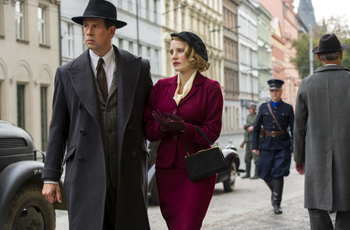 About The Production
About The Production
The Zookeeper's Wife is a film written and directed by women, about an unheralded female heroine. The project made it to the big screen after a decade as all concerned took inspiration from the real-life woman whose story they would be telling.
In 2007, producer Diane Miller Levin was given Diane Ackerman's book The Zookeeper's Wife, as a gift by her husband. Levin was so enthralled with the recounting of strength of character that she read the book in just one night, 'sitting on my stairwell. I was utterly struck by it. It felt like too important a story not to tell." Her producing partner, Emmy Award winner Robbie Rowe Tollin, read the book and was equally inspired by it. Together, they formed Rowe Miller Productions with a commitment to see the book adapted into a major motion picture.
Ackerman's nonfiction book drew on the wartime diaries of Antonina Żabińska while also providing in-depth research to place Antonina and her husband, Dr. Jan Żabiński, in the wider historical context of Polish resistance to Nazi oppression during WWII. Robbie Rowe Tollin states, 'What sets this apart from other WWII histories is that it is an intimate story between a husband and wife. We were fascinated at how it was about a family fighting to keep their everyday life, and marriage, healthy amidst a war."
The State of Israel would later honor the Żabińskis as Righteous Among the Nations, but the couple remained modest about their achievements. Yet they had exemplified courage and compassion, sheltering over 300 people at their beloved Warsaw Zoo, which had sustained damage during Germany's invasion of Poland, keeping these guests safe and surviving the Holocaust; saved from the Warsaw Ghetto, the rescuees were later sent on escape routes to freedom. A small number of their guests are still alive today.
Diane Miller Levin comments, 'This story celebrates life in all forms. Diane Ackerman showed us a world where humans, animals, the spirit of all living things, are valued. Specifically, it's about the heroism of a woman living in a time of unmitigated fear and destruction. Antonina's instincts were both scientific and spiritual, truly a rare combination. She knew how to spot a predator and how to defuse their aggression, but she also knew how to tend to a wounded animal and how to heal them. Overcoming her natural shyness, she applied her innate understanding of animal psychology to humans, and so was able to help even the most damaged escapees to heal and feel hope for the future. 'Robbie and I were floored at how Antonina answered a call to action and accepted so many challenges: hiding people in abandoned animal cages and underground tunnels, sacrificing to feed the guests and bolstering their spirits with music – all the while putting her life and the lives of her children on the line. We were moved by how Antonina and Jan fought against hate and for survival, no matter the cost to themselves.
The book eloquently depicts their bravery, and we wanted to translate that into a film." The duo brought The Zookeeper's Wife to the attention of Mike Tollin, an Emmy and Peabody Award winner with an accomplished track record of making movies about real-life heroes. He optioned the book for a partnership between his Tollin Productions and their Rowe Miller Productions. He comments, 'The book was a revelation. The chance to tell such an incredibly powerful and largely unknown story seemed like the opportunity of a lifetime."
Producer Kim Zubick, at that time President of Production at Tollin Productions, rounded out the quartet as they worked at selecting a screenwriter and developing the adaptation. Kim Zubick remarks, 'I felt in my soul that Antonina's story needed to be told. Wars are not just fought on the front lines; here was someone battling to hold on to what is good in people. Her story could inspire all of us to do the same.
'I knew we needed to find the right voice to tell Antonina's story, and it was immediately clear that this person was Angela Workman, our screenwriter. Angela brought her own passion to the table; it was on the strength of her faith in the material and in our collaboration that she came up with a powerful treatment, which gave us a strong foundation to build from."
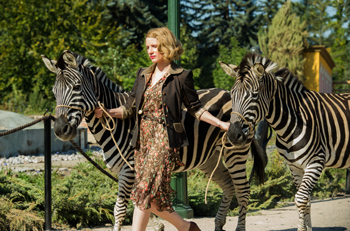 Workman notes, 'As a writer, so much of this story surprised me; there were so many things I didn't know. There was an -underground railroad' in Warsaw. There was an extraordinary effort by Gentiles to get people out of the Ghetto. The zoo became a way station in that effort; Jews were hidden inside the cages, in the underground animal tunnels, and inside the Żabiński house itself. This was an intensely dangerous act because German soldiers swarmed all over that zoo; their armaments were housed there – and in occupied Poland the punishment for hiding Jews was death to the rescuer and to his/her family. Antonina and Jan could have fled, but instead they made the decision to stay, to save lives, right under the noses of the Nazis.
Workman notes, 'As a writer, so much of this story surprised me; there were so many things I didn't know. There was an -underground railroad' in Warsaw. There was an extraordinary effort by Gentiles to get people out of the Ghetto. The zoo became a way station in that effort; Jews were hidden inside the cages, in the underground animal tunnels, and inside the Żabiński house itself. This was an intensely dangerous act because German soldiers swarmed all over that zoo; their armaments were housed there – and in occupied Poland the punishment for hiding Jews was death to the rescuer and to his/her family. Antonina and Jan could have fled, but instead they made the decision to stay, to save lives, right under the noses of the Nazis. 'A zoo setting for these acts of courage is unusual, and beautifully cinematic. But it also makes us think about the idea of animal instincts, human and non-human. Who are the beasts, really? Life in a zoo illuminates the core idea of how Hitler would ultimately be defeated: you can't control nature. The world turns forward, nature survives. Animal life survives. It will outlive a despot."
Robbie Rowe Tollin says, 'All four of us felt that Angela was a master at historical adaptations. What we found was that she was equally passionate about Antonina's character and the material."
Levin reports, 'Angela wrangled so many facts and details. She centralized the story with imagery while also making it come alive through the beauty of her words. 'Over this past decade we developed amazing partnerships, as it truly does take a village to make a movie."
Producer Jeff Abberley acquired the rights to the project in late 2009 through his Scion Films banner, having been introduced to it by Workman's agent Sandra Lucchesi, who became something of a 'fairy godmother" to the project. He muses, 'We had developed something of a reputation for helping to get some very complex projects made over the years, and instinctively I immediately knew that we could bring this wonderful project to the screen. Any movie is difficult to make. But a female-driven drama set against the Holocaust was too great to pass up. Here was a chance to tell an inspiring true story – about a family that extends itself further and further, both in risk and embrace.
'I only had two conditions before taking the project on: first, Angela had to write it, and second, we had to get the cooperation of the surviving children, Rys and Teresa. It took six months of careful negotiation but that was worth it."
He adds, 'From the very first meeting with director Niki Caro, it was abundantly clear that she knew exactly how to make this movie. She understood what was important in the telling of Antonina and Jan's story, and what was less relevant. The confidence that she had from the outset emboldened all of us. Her mastery of storytelling and the lyricism in her approach – not least with children and animals – mapped out the emotional heart of The Zookeeper's Wife."
Kim Zubick notes, 'One of the first things Niki said was, -I am not interested in making a war movie' – which was fun to recall as I watched her take great delight in overseeing fires and explosions during filming – but, rather, her vision was that the story should be told from a more feminine point of view, through Antonina's instinct to safeguard the guests' spirits and try to preserve that which makes us human. With Niki's input, Angela did another draft of the script and it soared."
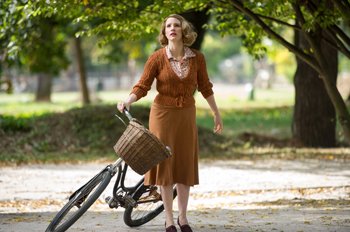 Niki Caro clarifies, 'The first 20 pages of the initial draft were some of the best I'd ever read in a script, and these went unchanged for the final film. I was lucky to have Angela as our screenwriter; she knew the source material so well that together we could envision what the movie should be. Diane's book was a resource for the texture of the film, as she had researched and recorded everything so poetically.
Niki Caro clarifies, 'The first 20 pages of the initial draft were some of the best I'd ever read in a script, and these went unchanged for the final film. I was lucky to have Angela as our screenwriter; she knew the source material so well that together we could envision what the movie should be. Diane's book was a resource for the texture of the film, as she had researched and recorded everything so poetically. 'I embraced how this story was very exotic, very domestic, and very feminine. Above all, it was an opportunity to explore what makes us human – and, humane."
Producer Jamie Patricof remarks, 'It's a unique story with a title that doesn't automatically connotate -a World War II film' and that does pique people's curiosity. Who could have imagined a miracle like this happening during that time?"
Patricof joined the project after Niki Caro and Workman had begun working together, and found that 'Niki Caro both knows exactly what she wants and is incredibly collaborative. She was always moving to bring authenticity into every aspect of telling this story."
Levin adds, 'Niki Caro was able to see Antonina in a new light, which people's survival stories could be dramatized, and what the pulse of the zoo would be. If you've seen her other movies, you know that she zeroes in on intimate and delicate moments in her film that she puts together like lace, but she also plunges into moments of conflict which test her characters. That certainly described Antonina's life, which we needed to show. 'We didn't hire Niki as our director because she was a woman; we hired her because she was the right person for this movie, being both pragmatic and creative."
Workman remarks, 'Adapting any book into a screenplay is a challenge. With nonfiction, you are confronted with names and statistics. But I knew that Antonina was the engine for the story, and so I had to build a storyline that centered on her, and that moved the film forward over the course of many years.
'After I met with Niki, we would communicate via phone and e-mail. She would float ideas to me, I would think about them, respond in writing; it was like a quiet dance over the miles. Niki has a gentle way about her but is just so astute with her ideas. We had a shorthand almost immediately. Working with her was a collaboration and a joy."
Niki Caro adds, 'At the script stage, I was always thinking about the tension of being caged – whether as an animal or human – and the visual storytelling was colored by that. It meant we shot through iron bars a lot, which is more difficult than I ever imagined…
'What we always came back to was the truth of the Holocaust, and how it was impacting the world and in particular this community. We researched documentary evidence on the Holocaust and the Warsaw Ghetto; the children, the starvation, the poverty, the sickness, the overcrowding…somehow you have to express it in a way that people can handle. There can be no flinching from it."
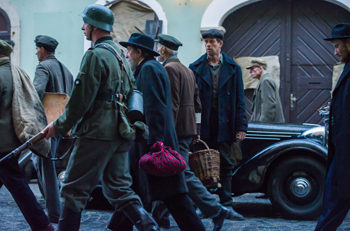 To play the lead role of Antonina Żabińska, the filmmakers needed an actress who would not flinch from the range of emotions required to honour the subject. Jessica Chastain was at the top of everyone's list; she was sent the script and then met with Niki Caro. Jessica Chastain committed to the project, and would remain so through the several years that it took to roll the cameras. To that end, she became an executive producer on The Zookeeper's Wife. She amassed her own research on the period and the character, and visited the Warsaw Zoo – which reopened a few years after the war ended – to get a sense of the environment.
To play the lead role of Antonina Żabińska, the filmmakers needed an actress who would not flinch from the range of emotions required to honour the subject. Jessica Chastain was at the top of everyone's list; she was sent the script and then met with Niki Caro. Jessica Chastain committed to the project, and would remain so through the several years that it took to roll the cameras. To that end, she became an executive producer on The Zookeeper's Wife. She amassed her own research on the period and the character, and visited the Warsaw Zoo – which reopened a few years after the war ended – to get a sense of the environment. She says, 'Here was an incredible arc for an actress to play. I wanted to portray Antonina because I love the compassion she exemplified and the heroism in that compassion. I also responded to the character trait in the script of how she read energy in people and also in animals. She had to be wary yet confident.
'I was fascinated at how the healing that she tried to provide for the guests included a strong musical component. She was a classically trained pianist, and I wanted to convey how she was keeping that as a beacon for people, the pride and the culture."
Antonina and Jan's daughter Teresa Żabińska remembers, 'Several of our guests played as well, when concerts were held in the evenings.
'The piano held a special importance in the house during the occupation because it was used to play an alarm signal. It was my mother's idea to choose the Offenbach operetta excerpt as the warning that everyone who lived there had to get to their designated hiding places." As heard in The Zookeeper's Wife, that excerpt is 'Pars pour la Crête (La belle Hélène)" [a.k.a. 'Beautiful Helen"].
Jessica Chastain, not a trained pianist herself, learned to play excerpts of classical music especially for The Zookeeper's Wife. She had played a small Chopin piece for an earlier movie, but this time she needed to master at least a minute each of several different composers' works. Accordingly, Jessica Chastain undertook two months' worth of piano tuition before shooting began and then continued her training even after filming began.
Workman remarks, 'I don't think Antonina ever called herself a hero. That she would not speak to this makes her an interesting subject, and is one of her contradictions – that's -contradictions' rather than -faults,' which are not the same things. What particularly fascinated me was that she felt compelled to make a sanctuary for frightened, persecuted people.
'Antonina, I feel, was extraordinarily vulnerable; it's what made her so tender with animals. But still, she found her will, her strength, to act with immense bravery, in spite of that vulnerability, or maybe as a result of it. She understood a fearful animal. We needed to look at how frightened she was, how her strength had to come from a deep reserve. Jessica Chastain was interested in exploring that dichotomy in her character."
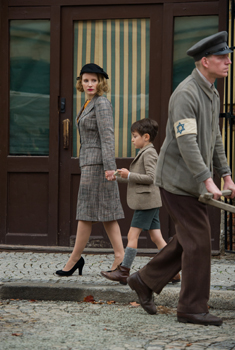 For Jessica Chastain, 'there was a lot in the script to work with, and one thing I noticed was that she never really questions her husband in the beginning of the film. She's quite submissive. But as events progress, she is able to be equal with humans, as she is with animals. She becomes stronger.
For Jessica Chastain, 'there was a lot in the script to work with, and one thing I noticed was that she never really questions her husband in the beginning of the film. She's quite submissive. But as events progress, she is able to be equal with humans, as she is with animals. She becomes stronger. 'I get very possessive when playing a character; I want to access their secrets and fears. Niki would work with me to elevate a scene and try things out but we would never go for something that was not real for Antonina, that she would not have done or been." Jessica Chastain adds, 'I've never been on a set with as many women as we had working on The Zookeeper's Wife, which made for a richly collaborative experience. It was great to have a female camera operator, Rachael [Levine], and stunt coordinator, Antje [Rau]."
Actor Daniel Brühl, cast opposite Jessica Chastain as Lutz Heck, the Nazis' newly appointed chief zoologist who is something of a predatory animal himself, found that 'Jessica carries this elegance with her, reminding me of an actress from the 1930s or 1940s. Sometimes I would get transfixed by how perfectly she inhabited the period."
Patricof points out that the actresses of that time period 'played multi-faceted characters, complicated women. The role of Antonina has different layers. She is the wife of an exceptional man, but she is also her own extraordinary self. She has to handle the Germans – these men who are circling her – and also be a mother and a mother figure. Jessica Chastain was uniquely suited to impart all of this into one performance."
Jessica Chastain confides, 'Between filming some of the darker scenes, I didn't want to stay in-character the whole time; I find that draining, when there are many emotions. Daniel has a wicked sense of humor, so I would be laughing with him once -cut' was called."
Brühl honed in on striking contradictions within his own character. The real Heck was controversial figure, a supporter of the Nazi Aryan ideal and the creation of not just perfect humans but also perfect animals through selective breeding. Heck's breeding projects were brainstormed to return extinct 'super beasts" to life, most notably his obsession: the Auroch, an extremely powerful bison once common in German forests. The actor notes, 'I was fascinated by both the book and the real history behind it. When we first get to know Heck it is as a friend of the couple; they share the same passion and love for animals. After the German invasion, he changes and becomes far more committed to the Nazi party and their ideals – which is a shock to Antonina and Jan. I wanted to play the paradox of his being into nature and the protection of animals while also being a defender of the atrocities the Nazis were committing.
'He sees keeping the Zoo around – running as a pig farm – as a chance to get closer to Antonina not only because he's attracted to her but also because he respects her talent with animals and imagines they share a special gift. He in fact did save some of the animals, but that was egotistically motivated because they were being transferred to his own zoo in Germany. At all times, Antonina has to try to anticipate his instincts."
Abberley adds, 'Heck did care deeply about animals and yet was also fully prepared to experiment on their genetics in an effort to bring about some mythological beast. As we know all too well, in the Nazi party there were doctors experimenting on humans for -purification' and Heck was attempting something comparable on animals.
'Daniel is an actor of great charm who transmits intelligence on-screen in a way that is mesmerizing. But he could also show the menace that Heck was capable of."
Niki Caro states, 'I felt it was important to avoid the moustache-twirling villain stereotype. What I found in Daniel was not afraid to play the complexity of his character."
If Heck's motives for what he did were complex, Jan Żabiński's were much clearer. Workman points out that 'the Warsaw Ghetto was right across the river from the Warsaw Zoo. The Holocaust was happening in front of their eyes."
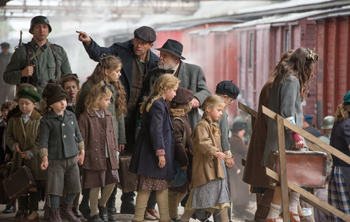 Flemish actor Johan Heldenbergh, whose favorite book is Jerzy Kosinski's The Painted Bird, which explores WWII in Poland, was keen to convey how the zookeeper progressed over five years' time 'from a liberal-minded intellectual into a soldier. What I believe he found was his that love for his country and his need to protect his fellow man was an even stronger motivation than staying safe. Jan, who thought he knew animals, found himself questioning whether he understood the human animal any more. It's important that we recognize how humans can be frightened and themselves turn into mistrusting, dangerous animals."
Flemish actor Johan Heldenbergh, whose favorite book is Jerzy Kosinski's The Painted Bird, which explores WWII in Poland, was keen to convey how the zookeeper progressed over five years' time 'from a liberal-minded intellectual into a soldier. What I believe he found was his that love for his country and his need to protect his fellow man was an even stronger motivation than staying safe. Jan, who thought he knew animals, found himself questioning whether he understood the human animal any more. It's important that we recognize how humans can be frightened and themselves turn into mistrusting, dangerous animals." He notes, 'Each individual's story of the Holocaust is different. There are those who embraced trust. Whether it is Oskar Schindler's story [in Schindler's List] or Wladyslaw Szpilman's [The Pianist] or Jan and Antonina's, these stories must be told – and retold. 'Carrying with him what he sees places a heavy emotional burden on Jan. He goes into the Warsaw Ghetto, and goes on to fight in the [1944] Uprising. His daily battles are more visceral than those experienced by Antonina; I can't imagine going through what he did, seeing what he saw, getting children to hide amidst garbage. He shields his wife from much of what he sees and hears outside the zoo, to protect her and their children, but when you start keeping secrets from a spouse, that's hard on a relationship."
Levin comments, 'They were partners in life and partners in danger. Yet Jan created some distance between he and Antonina during the war. It was painful but necessary; he wanted to keep her from worrying about him even more than she already was."
Kim Zubick remarks that for the filmmakers 'Jan was the hardest character to find on the page, and then the hardest one to cast. He was so stoic, trying to protect Antonina and his children from the realities that he was confronting. Johan brings a layer of emotional accessibility to Jan, which became a real access point into the relationship between him and Antonina as well as illuminating what drove the man to take the risks he did. Johan crafted the portrayal beyond even what we had expected, and it was beautiful to see."
Teresa Żabińska visited the set and spoke with the actors and filmmakers. She reveals, 'My father was not a sentimental man, and he was quite serious. But at the same time he had an incredible sense of humor; Mom did too, although of a different kind."
Heldenbergh says, 'I do feel that Jan was more the brains of the zoo and Antonina was more the soul of the zoo. He would look at animals in scientific terms, while she would connect with them in ways that he could not. Her work influenced him to change the zoo into a natural habitat, which was a progression they had almost completed when their country was invaded.
'The way Jessica saw Antonina made a difference in how I saw Jan. Also, her playing Antonina as vulnerable allowed me to play it stronger. Niki reminded us that it was how men and women carried themselves, in that time, in their relationships."
During the casting process, it was Jessica Chastain who had recommended that Niki Caro and the producers watch Heldenbergh's performance in the award-winning The Broken Circle Breakdown. Jessica Chastain remembers, 'I was blown away by that film, and thought, -This is an actor I want to work with!' Johan is dynamic, and can express so much with just a look. He is soulful."
Niki Caro elaborates, 'Johan registers as very masculine, yet he is completely emotionally open, which is exciting. He's solid, and he's sensitive – and he has a strong profile. 'Whenever I go through the casting process on a movie, I am extremely sensitive to the truth of the story. I love to work on fact-based material, and am always looking for the most authentic actor for the role."
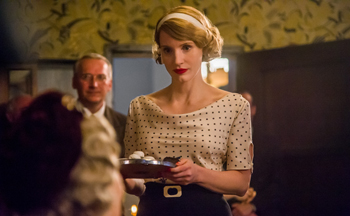 Having made movies revolving around specific cultures, Niki Caro is attentive to more than just the top-billed actors on a project. She explains, 'This movie was huge, so there were over 60 people that I chose for not only their talent and skill but also for their personal connection to the material. This ensures that when we get to the set, I am working with people who have a mainline into the truth of the story. On The Zookeeper's Wife, I was determined to avoid anything sentimental.
Having made movies revolving around specific cultures, Niki Caro is attentive to more than just the top-billed actors on a project. She explains, 'This movie was huge, so there were over 60 people that I chose for not only their talent and skill but also for their personal connection to the material. This ensures that when we get to the set, I am working with people who have a mainline into the truth of the story. On The Zookeeper's Wife, I was determined to avoid anything sentimental. 'It was a privilege on this movie to collaborate with actors who inhabited their characters, and the reality of the time and place, so effortlessly and passionately."
Israeli actress Efrat Dor portrays Magdalena (Magda) Gross, the esteemed Polish-Jewish sculptress who was known for her earth-toned animal depictions which were inspired by her lengthy and contemplative visits to the Warsaw Zoo. She was a close friend of Jan and especially of Antonina.
Dor read the script and 'was very moved. It was beautifully written. My grandmother is Polish and Jewish, and she lost her entire family in the Holocaust. I felt, in some way, this would be telling her story. I mixed in Magda Gross with my grandmother for the portrayal; she was the first person I told about the project once I was cast, and she shared stories with me about how it was. When filming some of the scenes, I burst into tears because I was thinking about her.
'In hiding, Magda can't really make art any more, yet she keeps a piece of clay with her – as a way of not giving up. After the war, she resumed sculpting and got married." Magda Gross's life partner was Maurycy Fraenkel, portrayed in The Zookeeper's Wife by Iddo Goldberg – who, like Dor, lost relatives in the Holocaust. Fraenkel was a well-respected and prosperous lawyer as well as an active patron of the arts and the Warsaw Zoo. He had been incarcerated in the Warsaw Ghetto until he was reunited with Magda at Jan and Antonina's villa.
The actor reflects, 'My sense is that the invasion of Poland snuck up on so many Jewish people. A few had read the writing on the wall and got out of Warsaw, but many more couldn't for a second imagine that this was going to happen.
'It was incremental; first, there were all these decrees issued against the Jews. You can't walk on the sidewalk with a German, you can't look a German soldier in the eye, you have to turn over your property to someone else, you can't leave the Ghetto. Slowly life was being taken from them."
Standing in for those whose childhood was forever scarred, the character of the orphaned Urszula is portrayed by a rising star, Israeli actress Shira Haas. Niki Caro reveals, 'I asked for this character to be created for the film. It was important to represent the brutal horror of war; what it does to children is par
ticularly heartbreaking. But Urszula also comes to exemplify hope and healing." Haas saw her character as 'a frightened animal, really. She has lost her family and is surviving in awful circumstances in the Ghetto until things get even worse. Jan moves to save her on impulse.
'At first, Urszula will not respond to Antonina or anyone. She can't interact with people; it takes her a long time to get back to believing in humanity. Her story is relevant to kids today, and we show how there is hope when people choose to help."
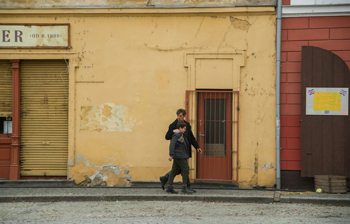 Haas worked closely with 'Niki, who I think is brilliant, on Urszula's shifts, whether it was in her eyes or her voice or her movements. Also, Jessica was such a good partner to me as an actress and as a person. Even when the camera was not on her in our scenes together she was completely there for me, and that safe feeling was so important."
Haas worked closely with 'Niki, who I think is brilliant, on Urszula's shifts, whether it was in her eyes or her voice or her movements. Also, Jessica was such a good partner to me as an actress and as a person. Even when the camera was not on her in our scenes together she was completely there for me, and that safe feeling was so important." Game of Thrones star Michael McElhatton was cast as Jerzyk, a Resistance member who is a trusted family retainer and confidant. McElhatton says, 'Jerzyk has worked for Jan and Antonina for a long time. He's a very loyal, stoic guy who becomes quietly heroic. The Warsaw Zoo is his home; he has no other life, and he realizes right away that by keeping his faith in it he can help the couple do a lot for people in dire situations. 'The script was very well-written, and my character is a man of few words. Niki and I discussed how Jerzyk is aware of class divides – and respects these societal structures –and we also worked on his physicality."
As the actors of different nationalities came together to tell a universal human story, dialogue coach Joan Washington was on call to help cast members work at capturing the cadences of Polish accents.
The Zookeeper's Wife cast was then rounded out by a self-contained yet wild ensemble – namely, real animals. CGI and effects work were kept to minimum, utilized only for the disturbing or dangerous scenes involving animals, including the images of fatalities.
The animal cast included big cats and cubs, zebras, monkeys, camels, elephants, wolves, bison, horses, pigs, birds of prey, a parrot, a skunk, and yet more species. Animals were recruited from professional handlers who work regularly with film and television productions, as well as from private individuals. Polar bears and giraffes were filmed separately in habitats at the Prague Zoo and edited into the main filming unit's footage. All animals had their own handlers on-set, some of whom were in period costume so that they could accompany the animals on-screen. The animals were never handled without expert supervision, and animal handlers and veterinarians were embedded with the production 24 hours a day.
Niki Caro knew that animal costars would create more on-set challenges, but for her 'there was no other decision than to have real animals. It seemed like it would be a cop-out to tell a real story and then put fake animals in it. No question that you can make animals out of a computer impressively well, but they're always going to behave as directed…
'…and the thing about animals is that they're totally unpredictable. They act according to their natures, and to their environment. I am opposed to animals learning tricks for the camera. I'm a human being so I can't tell a tiger how to be a tiger. A tiger is perfect in and of itself. So we needed to create an environment on the set where the animals could be free to behave exactly as animals do."
 Patricof confirms, 'We all figured, let the animals be animals. If the script said that an animal does one thing and it decided to do the opposite, then we would make that work. The scenes with them feel that much more real as a result, as their human costars were fully engaged."
Patricof confirms, 'We all figured, let the animals be animals. If the script said that an animal does one thing and it decided to do the opposite, then we would make that work. The scenes with them feel that much more real as a result, as their human costars were fully engaged." Production designer Suzie Davies spared no expense and worked creatively to construct safe, comfortable enclosures for the animals. She created an idyllic temporary home for them, one that also reflected the style of a 1930s zoo. For any and every scene, the production was careful to observe animal treatment standards including minimum repetition that would always respect animal capabilities.
Abberley offers, 'It was all about keeping the project as realistic as possible, and real interaction for our actors with these beautiful animals – with no harm being caused to them –would mirror what made the Warsaw Zoo so special in its time."
Teresa Żabińska recounts, 'My mother was not a zoologist by education; my father taught her the basics of working with them. She had an interest for it, good intuition, and an incredible talent."
An animal lover since childhood, Jessica Chastain relished the opportunity to be hands-on with her costars. As part of her extensive preparation for the film, she spent time with the zookeepers of Brooklyn Zoo in New York City.
Niki Caro marvels, 'The combination of real creatures and an actress who has an otherworldly connection to them made for extraordinary moments. Jessica was critical to my vision for the movie, and when I met her the first thing she said was that she loved animals. But I had no idea of the depth of her affinity with them. In that regard Jessica and Antonina share a very, very rare gift. Many times during shooting, Jessica would calm the animals, make them feel safe. This was a joy to watch and certainly a joy to shoot."
Jessica Chastain confides, 'Animals are very therapeutic. By caring for them on the set, I wasn't wallowing in my own exhaustion!"
Kim Zubick remarks, 'Jessica resembles the real Antonina in many ways, one of which is her ability to interact with the animals. She had a sixth sense with them; they would show spontaneity and emotion with her."
The elephant-birthing sequence paired Jessica Chastain with a full-grown elephant – one whose roving trunk was constantly in search of the apples concealed in her costume. With regard to the newborn elephant, Davies joked that 'there was no way we were going to get an elephant to give birth on cue for us."
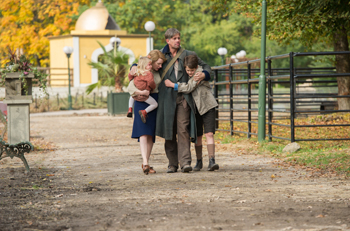 So for the newborn, the production team ordered up a prosthetic animal. Davies reports, 'We had this baby elephant built with a little hole behind its ear where you could put a hand in and move all the different structures inside, making it seem to breathe and seem real."
So for the newborn, the production team ordered up a prosthetic animal. Davies reports, 'We had this baby elephant built with a little hole behind its ear where you could put a hand in and move all the different structures inside, making it seem to breathe and seem real." Extensive filming was done on location in the largely abandoned fortress town of Josefov, situated approximately two hours outside of Prague in the Czech Republic.
Kim Zubick states, 'With full support from the Czech film commission, the city allowed us to create incredible imagery in real environments. Our Czech crew members and extras were invaluable to realizing Niki's vision for the movie. After living with the project for so long, having new colleagues bring their skills to bear on it was so exciting.
'We were able to block off streets which we dressed to look like Warsaw, in which we then set free an array of wild animals to roam We had tigers, kangaroos…What had happened in 1939 was that the animals who survived the attack on the Zoo fled into the city, wandering the streets until they were captured."
Second unit director and visual effects supervisor Robert Grasmere reports that 'working with the animals was a pleasure; they behaved better than a lot of humans I know..."
Grasmere captured footage of animals depicting them after the devastation of the zoo, concentrating on lions, zebras, and camels. This lensing entailed closing off and safeguarding a working street and then letting the animals wander and explore the bombed-out set, one species at a time. He remembers, 'The animals were extraordinary. They went into this space and we just let them go; we didn't tell them what to do or give them any cues. They had a great time. One prop was a baby carriage that had been abandoned in the bombing, and a lion went over and played with it."
McElhatton remarks, 'That's part of what makes this story so unique: the animal element. Zoos throughout the world were impacted by these terrible events. They were not immune to the tragedy of war."
Even in scenes depicting the havoc that war has wrought, Niki Caro strove to convey signs of hope and renewal. To keep the overall look of The Zookeeper's Wife from becoming monotone and downbeat, she worked with department heads early on.
Cinematographer Andrij Parekh carefully mixed light and dark, particularly in the interiors. Niki Caro says, 'It was the first time I had worked with Andrij and I hope it's not the last. He completely understood when I said everything had to be real yet beautiful, and how I wanted to tell this story in a particularly feminine way. There are vehicles and soldiers and guns, but there are also textures and skin and fur – some sensual details. Those too are reality for this story's characters.
'It wasn't just that Andrij captured these facets; he was able to truly see them, and he lit them in the most exquisite way. We never approached The Zookeeper's Wife like -a period movie; we shot it like a contemporary movie so that you can feel as if you're right in it with these people and these animals."
Patricof, who had already made several features with Parekh, adds, 'Andrij is a fantastic director of photography, and something that separates him from other ones is that he listens while he is working. While looking through the viewfinder or the camera is critical, at the same time he will hear what people are saying and what's going on around him. The results are lovely and sometimes haunting."
Workman's screenplay and Ackerman's book both provided inspiration for the look and the feeling of the film. Davies remarks, 'For the art department, the descriptions were poetic. There was already plenty of research to draw from, but I felt I needed to do more. I'd designed WWII dramas prior so I had retained some of that knowledge. I went to Warsaw a couple of times and visited the Warsaw Uprising museum.
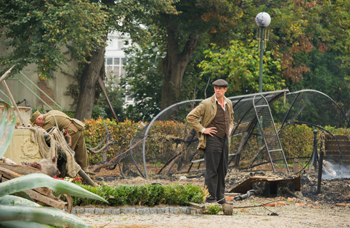 'Because the story extends into the 1940s, there was considerable photographic footage. What was important was, we were looking at not only the war documentation but also the domestic situations: what was the wallpaper like, what crockery did they use, what clothes were being worn, and so forth. That's when it really started to gel."
'Because the story extends into the 1940s, there was considerable photographic footage. What was important was, we were looking at not only the war documentation but also the domestic situations: what was the wallpaper like, what crockery did they use, what clothes were being worn, and so forth. That's when it really started to gel." The biggest single set was the Warsaw Zoo with the family's adjacent home, a Bauhaus design villa. To house the whole environment, a disused park in Prague was considered. Niki Caro remembers, 'Suzie had scouted Prague ahead of me, and she took me to a long-neglected Exhibition Park and said, -I think we could build a zoo here.' This was a bold vision, and I could see immediately how perfect it would be. We literally built our own zoo."
The family's actual villa still stands today, and was visited by the filmmakers for reference; it underwent renovations a few years ago, with part of it designated as a museum dedicated to Jan and Antonina. The zoo build took inspiration from several other European zoos of the period, in addition to the Warsaw Zoo itself. McElhatton marvels, 'The space went from a car park to something out of a fairy tale – incredible!"
Davies and her team including set decorator Charlotte Watts 'had to create a zoo that we could film in, and that could run for several months of filming including a change of seasons while staying sustainable. That's why there were components of different zoos, while always keeping Warsaw's as a key one. The Warsaw Zoo had a main central drag which we recreated, although ours was about one-eighth of the size of the real one. 'The single biggest challenge on The Zookeeper's Wife was building the zoo in five weeks during summertime. To see what we had accomplished lasting five months later with matured trees made all that concentrated work well worth it."
Although less sprawling, other sets and locations were also complicated. The villa, the hub of the family's domesticity, hewed very close externally to the original. Jan and Antonina's bedroom was created on-site, but the other rooms had to be filmed on studio soundstages. Davies reveals, 'I tried to make it feel textured and layered in every room, as human lives are. The basement was rendered a dark red to make it feel womb-like, or like a beating heart, because it is where lives are being saved and sustained: first animals and then people. Once survivors are being hidden there, a makeshift classroom gets added and there are laundry and sewing spaces, among other essentials.
'The next level of the house was the ground floor with its front room. This one we made a bit more showy and formal, because Jan and Antonina were part of the literati of Warsaw and it was a reception room. The block-printed wallpaper we used was from 1929; we found it in Antwerp. It's quite strong and bold yet lyrical, and it has the geometric detail so that it felt like music, and it also has flying birds – it was so apt for our story that I couldn't resist it!"
Also on the ground floor is a bustling kitchen, which Davies describes as 'organized chaos, full of detail where the cook is constantly at work."
Upstairs are the bedrooms, 'which are more personal and feminine. Jan and Antonina's master bedroom has navy-blue silk wallpaper, which was also period. What was important to show here, with the passage of time and with Jan being away, is how Antonina never gives up and never loses sight of keeping on; so there is always a flower, even when reduced to a weed, in the vase on the bedroom table."
Teresa Żabińska muses, 'When my father was absent, Mom had to keep everything functioning, and she was a motivating force. She took great care so that my brother Ryszard Żabiński and I could try to have a normal life, as if there was no evil happening outside."
The art department's attention to detail, echoing Antonina's own, impressed Jessica Chastain. She notes, 'The villa didn't feel like a movie set or too glamorous, which was important since we were making a film about real people. Suzy did an extraordinary job, including directly referencing Antonina's actual home."
Davies subtly advanced themes of the story and the history. She says, 'In the villa, we have nods to cages and boundaries. The spinal cord of the whole zoo is in the basement of that villa, as there are tunnels running all the way through and under. It's a lifeline that extends, and thrives.
'When showing the cages that housed animals and then protected humans, we would keep at least some doors open to show that there is captivity but also freedom." Kim Zubick reports, 'The basement set has all these different nooks and crannies where people hid. Charlotte Watts conceived histories for each item that had been preserved; for example, there is a rolled-up man's tie, which represents a husband lost in the war."
Perhaps the most meaningful work done by the art department was the mural on a wall of the cellar, which comes to stand as a symbol of resilience and community. Davies states, 'Niki wanted something reflecting a child's imagination. We looked at cave drawings and drawings by Jewish children in the Ghetto for inspiration, and from there we saw how we could evolve it.
'The texture on the wall was a very hard concrete render. We restricted our colors because it had to reflect what was in a child's coloring set and whatever else would have been available to supplement that. The end result is like folk art; it has a naïveté yet there's also this intense depth to it. The way that Andrij shot it is beautiful; the first time we see it, lit by candles, it looks like the figures are dancing across the wall."
Niki Caro elaborates, 'Suzie's department worked so hard to create it. I think it's Chagall-like, it dances and it has life – as the villa had life; there is animal and human life that can't and won't be eradicated, all the life of Jewish and Polish cultures that managed to survive and to thrive in this house despite the worst happening outside."
To depict the horror unfolding nearby, the production recreated the Warsaw Ghetto on location in Josefov. Buildings and courtyards were dressed to look like the Ghetto's 1.3 square miles, as the designers and costumers pushed themselves to re-create the German occupation in full. Davies reflects, 'We wanted to be authentic. But for this movie we felt we needed to express more; for example, how the Jews were forced out of their homes and into the Ghetto, carrying as much as they could. Their pockets were full, and everything was wrapped up in a curtain or rug. The Ghetto wasn't just bricks and mortar; it was clothes, cases, furniture, all with people trying to live, to keep living."
Abberley notes, 'This was a very emotional project for everybody, and the Ghetto sequences were particularly difficult to do. Recreating the Ghetto reminded us that these events didn't take place that long ago, and that similar events happen in different parts of our world today. We felt we had to convey the reality of 380,000 people herded into a small area and confined there for years while their conditions deteriorated exponentially day by day."
Patricof remembers, 'The filming of the Ghetto was some of the most challenging days I've ever had on a shoot. Suzie and her team had done such an extraordinary job of transporting you there. Seeing the scenes playing out, of people dying and the Ghetto burning, there were days where many of us would be in tears."
Kim Zubick reflects, 'I arrived on the Ghetto set just as the sun was coming up one morning. The set was a snow-covered street littered with people's belongings…suitcases, books...the remnants of those who had been shoved into cattle cars and shipped off to slaughter. At that moment, I was struck by the weight of all the stories behind the one we were telling."
Costume designer Sabine Daigeler, known as Bina, worked closely with make-up and hair designer Denise Kum through pre-production and production from research materials for both main cast and extras. The clothes of the key cast were all handmade, as Daigeler's mandate was materials and patterns accurate to the period. Daigeler reveals, 'I designed these clothes in a big work room where we then had 8-10 people sewing and stitching, including of multiples of the same costume whether for time progression or as backups – which were needed often after scenes with the animals!
'What's most helpful is to look at documentary footage and photos. Ultimately, we prepared a big planning book for the movie that was mapped out scene by scene." Niki Caro comments, 'The hair and make-up and wardrobe departments were fabulous. I don't say that lightly or frivolously; what these teams did with hundreds of extras, whether in the Ghetto or in the glamorous belle époque of pre-war Warsaw, was to see everything on the very last extra was truthful – because they cared. Whether it was seams on the stockings or clips in the hair, every performer was impeccably attended to."
Daigeler notes, 'For Jessica Chastain, it was vital to be dressed like the real Antonina, who was quite conservative for her period, and was very feminine. Today, a woman working daily in a zoo would wear pants and be much more casual, yet we knew from our conversations with Antonina's daughter Teresa that her mother just did it all in a everyday dress. I was a little bit worried how this would look, but Jessica is such a consummate actress that she made Antonina's style her own and it felt right."
Jessica Chastain admits, 'I was a bit shocked to see how feminine Antonina was. Teresa told me that her mother's hair was always done and that she loved lipstick. She also said that Antonina loved nail polish, but Jan didn't like it and so she rarely wore it. Everything I learned from Teresa helped me get at the nature of the woman who was taking care of all of these people; she is trying to bring any joy and happiness she can, and she takes care in her appearance because that is part of her not wanting anyone to forget that they are human."
Niki Caro confides, 'Teresa, who is depicted in the movie as a baby and then a small child, said that Jessica was just like her mother."
For Daniel Brühl, Daigleler took major inspiration from the German hunting style of tailoring. Heck is seen out of uniform well into the timeline, reflecting his more relaxed relationship with Antonina and Jan. Complementing this, Kum aged the actor subtly to reflect the decadent lifestyle of a German officer with food, drink, and other indulgences. Kum says, 'The female characters were aged even more subtly. I tried to make that process more poetic than literal."
Fans of Johan Heldenbergh may be surprised to see him clean-shaven as Jan Żabiński; aside from being accurate to the character and historical record, this allowed the actor to more fully express on Jan's face the range of emotions as his activities become more risky. Jan's clothing reflects both sides of the man's life: the academic's tailored suits and the zookeeper's practical work clothes, the latter of which get additional wear-and-tear during the Resistance efforts.
The costume department also bookmarked modifications in German uniforms as WWII progressed, making use of research as well as input from military uniforms advisor Harry Fakner. Even epaulets and buttons were carefully monitored for accuracy. Brühl marvels, 'We would be doing these wide shots where the precision and accuracy would be mind-blowing wherever you looked. The production design, the costume and make-up department – everything was impeccable, and Niki would keep everything going at an efficient pace."
The huge stock of costumes encompassed the rich and the poor, and adults and children. Clothes were brought in from all over Europe for 3,000 extras; then, considerable time was spent appropriately aging or distressing them. The Ghetto scenes were all filmed in a two-week period, but spanned three-and-one-half years. Flashes of color in, or underneath, the costumes of the Ghetto's Jews recall more humane times in their lives. Daigeler comments, 'Niki gave us a lot of creative freedom."
Dor remembers, 'There was one scene with my character where I wondered, -Would Magda wear a dress-up hat while all this is happening?' Then Niki and I discussed how it was a way to reclaim humanity when in hiding. As a director, Niki makes every actor feel important to a scene."
Goldberg notes, 'Not only is there a considerate atmosphere on the set, but Niki is also good at advising you on what's needed and what's not, such as when less emotion might be better for a scene."
Kum muses, 'Niki's approach is character-based. After having made a number of movies with her over the years I brought nuances to this project that I knew she would like and that would support the way she works.
'Niki privileges performers, so much then depends on who the actor is and what they bring to the table. I work quite fluidly with the actors while taking notes from Niki about what her viewpoint is. Then I bring my ideas to the table and we build it together with the actor. Even if people were in for only one or two days, we were always thinking, -What's happening with this character? What's their journey? How can we show that on-screen?' What truly helps create the world of the story is when you envision the cast together rather than singularly."
So it was that Kum and her department tended to extras in the Ghetto scenes by making sure that teeth weren't too white, roughening looks with dried-out-looking hair, and greying skin to show suffering and malnourishment.
All of which forcefully reminded everyone making the movie of events that are playing out across the world today. Jamie Patricof reminds, 'There is a quote from Primo Levi, who survived the Holocaust: -It happened, therefore it can happen again.'
'In making The Zookeeper's Wife, we hope that it will be a reminder to people: do not turn a blind eye to what goes on today in the world."
Diane Ackerman calls Jan and Antonina's efforts 'compassionate heroism. Jan was very brave in a more traditional kind of way. But Antonina represents the kind of heroism that is taking place every single day on our planet, even though we don't hear about it much; the media tends to feature heroes that are violent, and more full of hatred rather than kindness. These stories alarm us and we pay attention to larger-than-life people, but, why we don't feature the good side of human nature as often?
'Antonina did what she did with enormous generosity of spirit, as well as cleverness and an iron backbone. She was an unbelievably empathetic woman. She performed radical acts of compassion."
Teresa Żabińska remembers, 'For my parents, it was: a decent human being should behave decently. That was their natural belief.
'It's not true that my mother wasn't afraid. She always talked about it afterwards, how very afraid she was. But in dangerous situations, she knew intuitively and instinctively how to act and what to do."
Diane Miller Levin adds, 'Antonina and Jan realised that they could save a lot of lives. Yet I don't feel that they would think of themselves as heroes at all but rather as people doing what was called for.
'It's been a privilege to work on a film that confronts the face of hate. My hope is that people will see The Zookeeper's Wife, then ask themselves, -What would I do?' and then find the best version of themselves for today. It is never too late for acts of compassion and it is never too late to act; one person can make a difference in the world."
Kim Zubick elaborates, 'That's why this story is so important in today's world; it tells the story of the everyman. The two zookeepers were not equipped in any way differently than anyone else. But they held fast to their humanity."
Angela Workman says, 'We're all human, but sometimes refugees are perceived as -the other,' and for that reason we fear them. But we can choose to see them differently. We can choose to help someone we don't know, or think we don't know, if we see that they're human, like us, and in need."
Having made real-life stories into movies before, Niki Caro states, 'I take the responsibility of putting people's lives on film extremely seriously – and with a Holocaust story, even more so because there are so many souls to honor. I'm humbled by it and I'm honored to represent this on film.
'It's not possible to stay close to every fact, but I try to be spiritually faithful to the material and the subjects. Here was, and is, heroism at its essence. Anybody anywhere who wants to be inspired to do something good in their life can take that initiative from this zookeeper and his wife."
The Zookeeper's Wife
Release Date: May 4th, 2017
Have You Seen This?
MORE
- Mission: Impossible Fallout
- Glenn Close The Wife
- Allison Chhorn Stanley's Mouth Interview
- Benicio Del Toro Sicario: Day of the Soldado
- Dame Judi Dench Tea With The Dames
- Sandra Bullock Ocean's 8
- Chris Pratt Jurassic World: Fallen Kingdom
- Claudia Sangiorgi Dalimore and Michelle Grace...
- Rachel McAdams Disobedience Interview
- Sebastián Lelio and Alessandro Nivola...
- Perri Cummings Trench Interview


